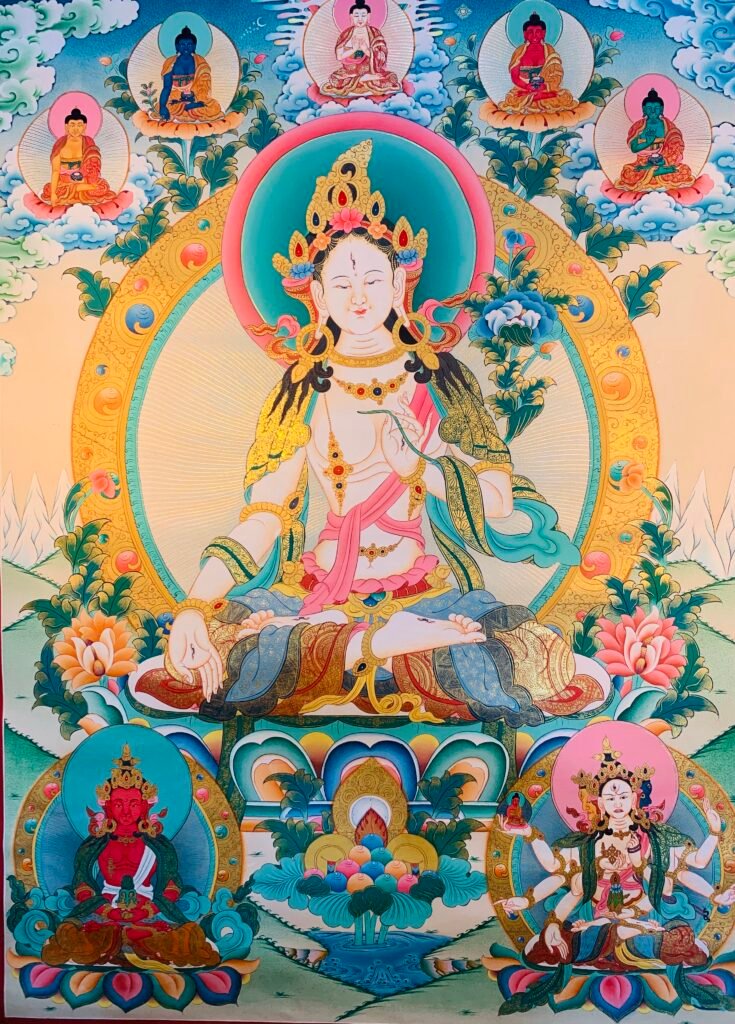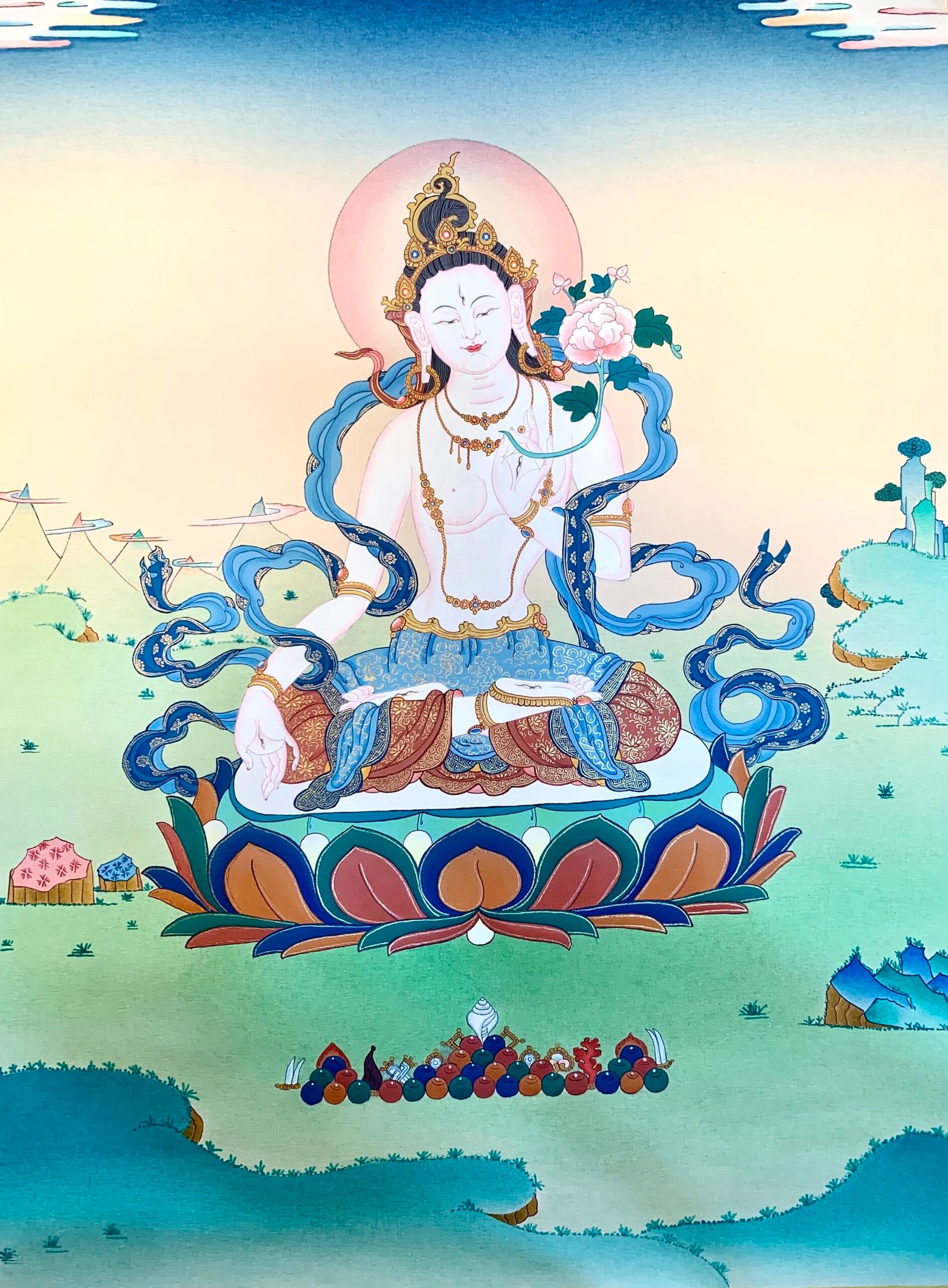“White Tara “(Sitatara) is associated with long life. Her mantra is often chanted with a particular person in mind. She’s another representation of compassion, and she’s pictured as being endowed with seven eyes (look at the palms of the hands, soles of the feet, and her forehead) to symbolize the watchfulness of the compassionate mind.
1. How is White tara looks like.

White Tara is an enlightened being appearing in the form of a young goddess, adorned with silks, jewels, and flowers. She sits cross-legged in meditation. She’s on a lotus, which symbolizes purity. The Buddha himself said that just as a lotus grows from muddy water, but has pure, unspoiled petals, he lives in the world untouched by it. In other words, although he was surrounded by selfishness and hatred, he himself was free of those things.
She has more than two eyes! She has a third eye in the center of her forehead, symbolizing the awakening of her vision as an enlightened being. She also has eyes in the palms of her hands and on the soles of her feet. These symbolize the fact that although she offers help in the world, she does not do so blindly, but is able to help people move toward awakening.
2. What is the symbol of white tara holding things in right hand and left hand?
Her right hand is open in a gesture of giving.
White Tara Her left hand holds the stem of a blue lotus (Sanskrit, utpala) which blossoms above her shoulder. This type of lotus opens at sunset and blooms at night. It has a sweet scent that symbolizes the way that an ethical life has an uplifting effect on the world.
The fact that she is the color of moonlight and holds a flower that blooms at night, suggests that White Tara appears in the form of a moon goddess.
White Tara As mentioned above, her mantra is often chanted with a particular person in mind. Disciples of a teacher might well chant the mantra with the wish that the teacher live long and be healthy, for example. Or one might chant the mantra for a friend who is ill or dying.”
3. What is the Mantra of “White Tara“?

Oṃ Tāre Tuttāre Ture
Mama Ayuḥ Punya Jñānā Puśtiṃ Kuru Svāhā
Unlike Green Tara, White Tara has both legs folded in meditation (Green Tara is stepping down onto a lotus).
As a variant form of Green Tara, her mantra begins very similarly. But added to the play on the name of Tara are several words connected with long life and wellbeing.
Mama means “mine” and indicates that you’d like to possess these qualities of long life, merit, wisdom, happiness, etc. You can of course choose to wish these qualities for someone else — perhaps for a teacher or for a loved one who is ill.
Ayuh is long life (as in Ayurvedic medicine).
Punya means the merit that comes from living life ethically, and this merit is said to help one to live long and happily.
Jnana is wisdom.
Punya and Jnana are known as the Two Accumulations. In order to become enlightened we need to accumulate merit (that is, to develop positive qualities through living ethically and meditating) but we also need to develop wisdom through deep reflection. Wisdom cannot arise without a basis of merit, but merit alone is not enough for us to become enlightened, meaning that becoming a nicer person isn’t enough — we have also to look deeply into ourselves and the world around us and to see the impermanent and insubstantial nature of all things.
Pushtim means wealth, abundance, or increase.
Kuru is a mythical land to the north of the Himalayas, which was said to be a land of long life and happiness (it may have been the original northern home of the aryans). Perhaps the association with the mythical realm of Kuru doesn’t hurt when doing the mantra. But here the word kuru is a verb form meaning “do it!” or “make it so!” (second person singular active imperative or the root kṛ if that’s of any interest to you) which is what it means here. With this “make it so!” we’re imploring White Tara for an increase in wisdom, merit, and long life so that we can gain enlightenment and help all sentient beings.
svaha is an exclamation meaning “hail” or “may blessings be upon” and is a common ending to Buddhist mantras. So after making the rather bold request of White Tara above, we end with an equally emphatic salutation.
With this “make it so!” we’re imploring White Tara for an increase in wisdom, merit, and long life so that we can gain enlightenment and help all sentient beings.
svaha is an exclamation meaning “hail” or “may blessings be upon” and is a common ending to Buddhist mantras. So after making the rather bold request of White Tara above, we end with an equally emphatic salutation.
The mantra then means something like, “May my life be long, may my good qualities and wisdom increase! Make it so! Hail!”

